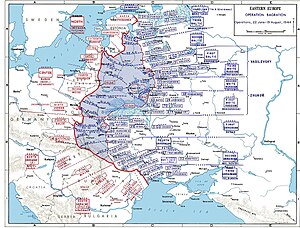
Back عملية باغراتيون Arabic Baqration əməliyyatı Azerbaijani باقریشن عملیاتی AZB Аперацыя «Баграціён» Byelorussian Апэрацыя Багратыён BE-X-OLD Операция „Багратион“ Bulgarian Operació Bagration Catalan Operace Bagration Czech Operation Bagration Danish Operation Bagration German
| Operation Bagration | |||||||||
|---|---|---|---|---|---|---|---|---|---|
| Part of the Eastern Front of World War II | |||||||||
 Deployments during Operation Bagration | |||||||||
| |||||||||
| Belligerents | |||||||||
|
|
Air support: | ||||||||
| Commanders and leaders | |||||||||
| Units involved | |||||||||
| Strength | |||||||||
|
Initially: 486,493 combat personnel[3] ~849,000 total[4] 118 tanks[5] 452 assault guns[5] 3,236 field guns and howitzers[5] 920 aircraft[5] In total (Soviet sources):[6] 1,036,760 personnel ~800 tanks 530 assault guns 7,760 field guns 2,320 anti-aircraft guns ~1,000–1,300 aircraft |
Initially: 1,670,300 personnel 3,841 tanks and 1,977 assault guns[5][7] 32,718 guns, rocket launchers and mortars[5] 7,799 aircraft[5] In total (Frieser): ~2,500,000 personnel ~6,000 tanks and assault guns[5] ~45,000 guns, rocket launchers and mortars[5] ~8,000 aircraft[5][8] | ||||||||
| Casualties and losses | |||||||||
|
Zaloga:
Frieser:
Glantz and House:
|
Glantz and House:[14]
2,447 guns[16] 822 aircraft[16] | ||||||||
Operation Bagration[a] (Russian: Операция Багратион, romanized: Operatsiya Bagration) was the codename for the 1944 Soviet Byelorussian strategic offensive operation[b] (Russian: Белорусская наступательная операция «Багратион», romanized: Belorusskaya nastupatelnaya operatsiya "Bagration"), a military campaign fought between 22 June and 19 August 1944 in Soviet Byelorussia in the Eastern Front of World War II,[c] just over two weeks after the start of Operation Overlord in the west. It was during this operation that Nazi Germany was forced to fight simultaneously on two major fronts for the first time since the war began. The Soviet Union destroyed 28 of 34 divisions of Army Group Centre and completely shattered the German front line.[17] The overall engagement is the largest defeat in German military history, with around 450,000 German casualties,[18] while 300,000 other German soldiers were cut off in the Courland Pocket.
On 22 June 1944, the Red Army attacked Army Group Centre in Byelorussia, with the objective of encircling and destroying its main component armies. By 28 June, the German 4th Army had been destroyed, along with most of the Third Panzer and Ninth Armies.[19][20] The Red Army exploited the collapse of the German front line to encircle German formations in the vicinity of Minsk in the Minsk Offensive and destroy them, with Minsk liberated on 4 July. With the end of effective German resistance in Byelorussia, the Soviet offensive continued on to Lithuania, Poland and Romania over the course of July and August.
The Red Army successfully used the strategies of Soviet deep battle and maskirovka (deception) to their full extent for the first time, albeit with continuing heavy losses. Operation Bagration diverted German mobile reserves from the Lublin–Brest and Lvov–Sandomierz areas to the central sectors, enabling the Soviets to undertake the Lvov–Sandomierz Offensive[21] and Lublin–Brest Offensive.[22] This allowed the Red Army to reach the Vistula River and Warsaw, which in turn put Soviet forces within striking distance of Berlin, conforming to the concept of Soviet deep operations—striking into the enemy's strategic depths.[23]
- ^ Baxter, Ian (2020). Operation Bagration: The Soviet Destruction of German Army Group Center, 1944. Casemate. ISBN 978-1-61200-924-7.
- ^ Roberts, Geoffrey (2006). Stalin's Wars: From World War to Cold War, 1939–1953. Yale University Press. p. 202. ISBN 978-0-300-11204-7.
- ^ Frieser 2007, p. 531.
- ^ Citino 2017, p. 171.
- ^ a b c d e f g h i j Frieser 2007, p. 534.
- ^ Glantz & Orenstein 2004, p. 4.
- ^ a b Glantz & House 1995, p. 132.
- ^ Glantz & House 1995, p. 201.
- ^ Zaloga 1996, p. 71.
- ^ Frieser 2007, pp. 593–594.
- ^ Алексей Исаев. Цена Победы. Операция «Багратион» Эхо Москвы. 17.08.2009
- ^ Glantz & Orenstein 2004, p. 176.
- ^ "Наша Победа. День за днём — проект РИА Новости". Archived from the original on 28 July 2013. Retrieved 7 July 2010.
- ^ Glantz & House 1995, p. 298.
- ^ Krivosheev 1997, p. 371.
- ^ a b Krivosheev 1997, p. 203.
- ^ Buchner, Alex. Ostfront 1944: The German Defensive Battles on the Russian Front 1944. Schiffer Publishing, Ltd. 1995, p. 212.
- ^ Norman Davies, "Europe at War", Swedish ISBN 978-91-37-13109-2, chapter 1, p. 40 in the Swedish translation (table of killed soldiers in the largest battles and campaigns)
- ^ Willmott 1984, p. 154.
- ^ Zaloga 1996, p. 7.
- ^ Watt 2008, p. 699.
- ^ Watt 2008, p. 669.
- ^ Watt 2008, p. 670.
Cite error: There are <ref group=lower-alpha> tags or {{efn}} templates on this page, but the references will not show without a {{reflist|group=lower-alpha}} template or {{notelist}} template (see the help page).